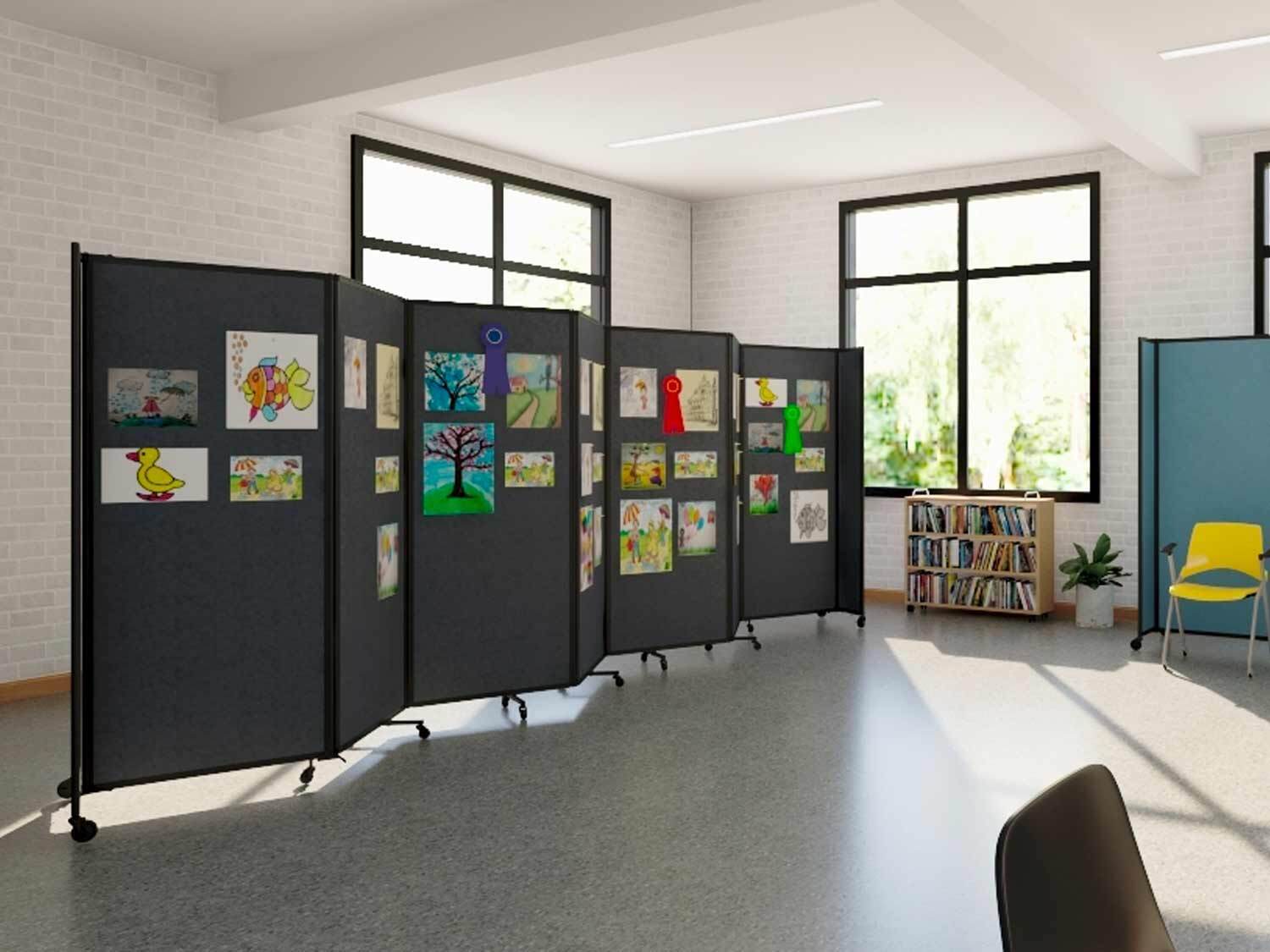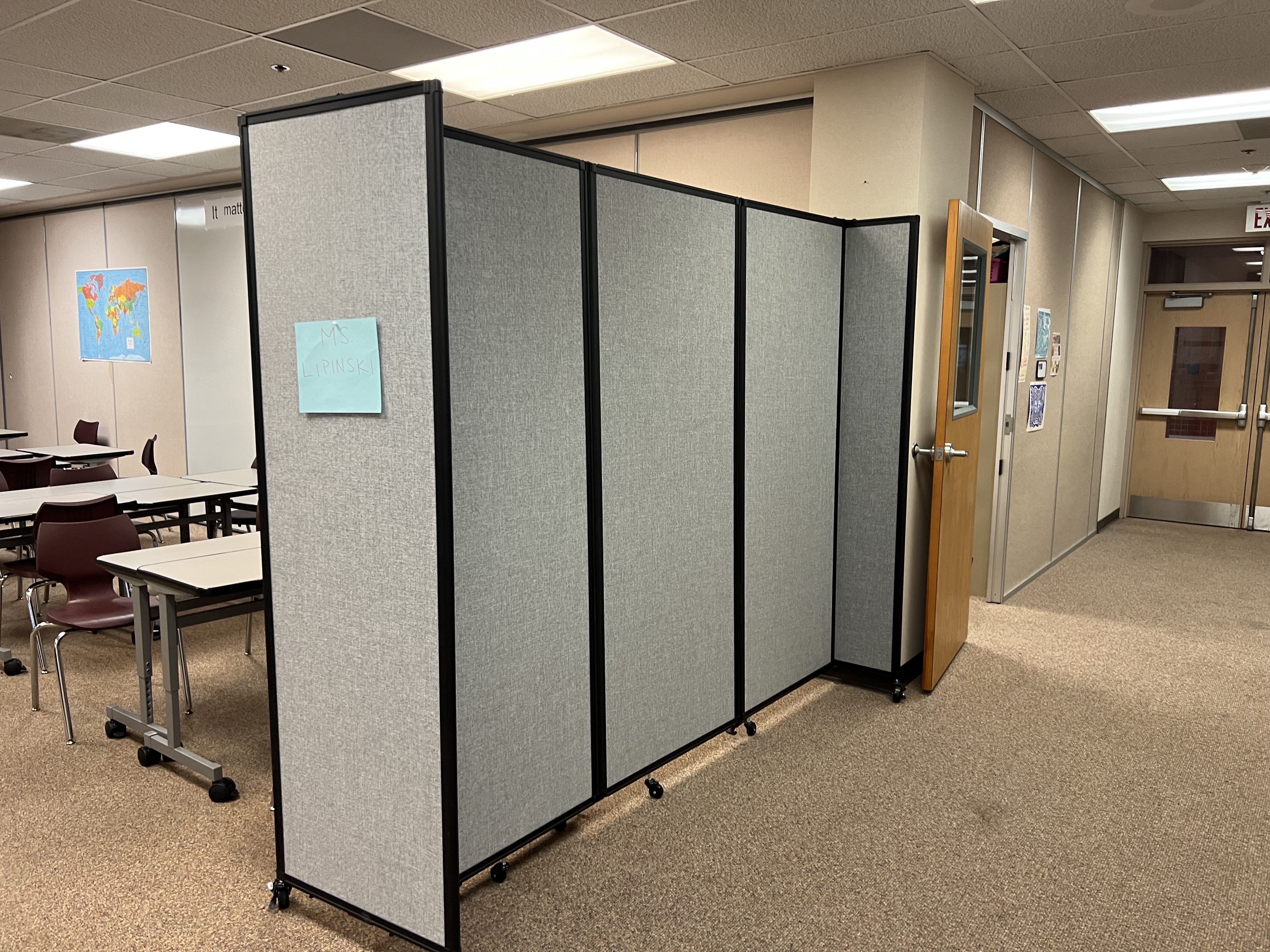How to Divide a Classroom
Posted by Kate Murphy on Jun 18th 2025

In modern classrooms, flexibility isn’t optional—it’s essential. As teaching evolves, so must the spaces educators teach in. Students thrive when they have room to move, focus, and engage with each other and the curriculum. When teachers can shape the space to match the moment, learning becomes more dynamic, inclusive, and effective. And the best part? You don’t need a big budget or a construction crew to make it happen.
Movable partitions, like rolling dividers and modular panels, make it easy to turn one room into many. Need a quiet corner today and a group zone in a snap? Rearranging takes minutes, not months, with dividers.
Flexible spaces build flexible minds. Here’s how to divide a school classroom with purpose, creativity, and ease.
Why Dividing a Classroom Matters
Gone are the days of rigid, one-size-fits-all classrooms. Rows of desks facing a chalkboard, the teacher planted at the front, and a “sit still and listen” lecture model ruled the school day. For decades, that setup was the norm—predictable and built around a one-directional flow of information.
Today’s classrooms are more fluid and interactive. Instead of assuming all students absorb information the same way, schools embrace differentiated instruction, collaborative learning, and student-led exploration. That means the physical space needs to keep up—and that can be achieved with a few smart classroom divider ideas.
By strategically using room dividers and partitions, educators can carve out spaces that serve specific functions—like reading corners, quiet zones, group collaboration areas, or individualized workstations. Dividing a classroom can help:
1. Reduce Distractions
The average U.S. class size hovers around 20 students throughout elementary, middle, and high school. While that number can vary depending on location, funding, teacher availability, and district policies, one thing stays the same: a room full of students can get noisy and visually overwhelming. Thoughtful partitioning helps create quiet zones where students can concentrate, read, or take tests with minimal interruptions.
2. Support Differentiated Instruction
Students learn at different paces and in different ways. Dividers allow you to create multiple instructional zones within one room—so you can lead a group lesson in one area while others work independently or in small groups elsewhere.
3. Accommodate Varied Teaching Styles
From learning stations to teacher-led discussions and collaborative work setups, having clearly defined spaces helps each method run more smoothly.
4. Improve Classroom Management
Dividers help organize the room so students know where to go and how to move around. Clear paths and separate zones can cut down on distractions, prevent crowding, and keep everyone focused.
5. Maximize Multiuse Spaces
Shared spaces, like art rooms or flexible learning areas, need to adapt quickly. Dividers make it easy to switch up the layout throughout the day, so one space can support a variety of activities without any permanent changes.
Assessing Your Classroom Needs Before You Divide
Before rearranging desks and ordering dividers, assess your current classroom setup and your goals:
- What do you need the space to do? Are you building quiet reading nooks, flexible breakout areas, or zones for centers and stations?
- Who are your students? Younger students may need clearly defined areas to help them transition, while older students might benefit from collaborative group settings.
- How’s the layout working? Think about lighting, visibility, and access to tools like whiteboards, technology, or storage.
- How flexible should it be? Will your zones change week to week, or even hour to hour?
Tip: Use a layout planner or a 3D space design tool before making changes. It’s a great way to visualize your ideas and find the perfect setup.

Popular Classroom Divider Ideas
Now that you’ve evaluated your needs, it’s time to examine divider options. There are several effective and affordable ways to section off your space—and many of them offer more than one function.
Portable Room Dividers
These freestanding, lightweight panels are perfect for temporary or mobile layouts. Teachers love them for:
- Testing zones
- Temporary small group instruction
- Privacy screens for counseling or assessments
Try: Workstation Screen, Privacy Screen, SoundSorb™ Acoustic Panel Kit, and VersaPanel™ Acoustical Partition Wall, just to name a few
Whiteboard Partitions and Display Boards
Whiteboard partitions serve double duty as space dividers and interactive writing surfaces. They’re especially handy in rooms with limited wall space, giving students and teachers more room to brainstorm, collaborate, and showcase work.
Tackable display boards also double as space dividers and visual hubs—perfect for posting student work, reminders, and learning aids. They keep classrooms organized, engaging, and easy to navigate at a glance.
Use these products for:
- Quick group brainstorms or visual learning
- Interactive student work areas
- Student art shows
Try: DivideWrite™ or ShieldWrite™, as well as Tri-Panel Display Board and Galleria™ Indoor Outdoor Display Board
Folding and Rolling Dividers
When storage is tight, folding or rolling dividers shine. These options are easy to collapse and tuck away after use, making them ideal for:
- Shared classrooms
- After-school programs
- Multi-purpose spaces (like gymnasium-classroom hybrids)
Try: Room Divider 360® Folding Portable Partition, StraightWall™ Sliding Portable Partition, MP10 Economical Folding Portable Partition, QuickWall® Folding Portable Partition, and more
Bookshelf Dividers and Storage Organizers
Maximize your space by turning storage into structure. Bookshelves, cubbies, or rolling carts can help define space while keeping materials organized. A well-placed bookshelf, for example, can separate different learning zones—like a reading corner or small group area—while still storing books, supplies, or labeled bins.
Just make sure your shelf is sturdy and low enough to maintain clear sightlines for easy supervision. Keep it clutter-free so it creates separation without making the room feel crowded or closed off.
Try: EverBlock® Shelves—Corner, Double, and Kit—in addition to the Rolling Cabinet.
Using Dividers for Specific Classroom Zones
Classroom dividers are essential for creating distinct zones that support different learning activities. For instance, reading corners benefit from dividers that form cozy, focused spaces where students can enjoy books without distractions. Acoustic panels take this a step further and Versare acoustic dividers stand out because they use high-density sound-absorbing cores and specialized fabric coverings to minimize echoes and noise. With an NRC rating up to 0.77, they’re ideal for creating quiet, focused learning environments.
In early childhood and elementary classrooms, dividers are especially useful for creating distinct centers or stations, such as art, science, or math corners. These clearly defined zones help young learners transition smoothly between activities and stay engaged. STEM learning spaces, in particular, benefit from modular solutions like EverBlock®, which can be customized to fit unique classroom needs.
Hint: Check out this article on designing effective EverBlock STEM spaces for more ideas.
Finally, dividers are invaluable tools for establishing clear pathways and transitions within the classroom. By guiding traffic flow and reducing chaos during transition times, these partitions help teachers maintain better classroom management and create a more structured learning environment.
Safety and Accessibility in a Divided Classroom
On the topic of clear pathways, a well-divided classroom should enhance and not hinder student movement and supervision. Keep these best practices in mind:
- Maintain clear visibility and don’t create blind spots. Use clear or low panels in high-traffic areas.
- Allow for wide, ADA compliant walkways to accommodate students with wheelchairs and mobility aids.
- Anchor dividers safely or use models with weighted bases to prevent tipping.
- Choose durable materials that are easy to sanitize and hold up to student wear and tear.
Designing for Flexibility and Focus
Just as students are tested on their knowledge, educators should regularly “test” their classroom setup to keep it running at A+ standards. A well-divided classroom is a flexible foundation that grows with your students and teaching style. As class sizes shift, curriculum changes, or student needs evolve, your layout should adapt, too. Rotating spaces based on seasons, lesson units, or behavior patterns can keep the environment fresh and functional.
Don’t be afraid to experiment—trial and error often lead to the best results. Student feedback can also offer valuable insight into what is working (and what is not). Involving students in setup not only fosters ownership but also promotes an inclusive, collaborative classroom culture.
And throughout every change, stay mindful of sensory needs, accessibility, and equity—because a well-designed space should support every learner, every day.
Ready to Put These Classroom Divider Ideas Into Action?
Dividing a classroom is about creating spaces that serve students’ needs in ways that feel organized, supportive, and inspiring. When you’re ready to turn ideas into action, start by looking at the Classroom Dividers page. If you have any questions about acoustic performance, durability, or design of Versare’s products, reach out to sales experts for personalized guidance, product recommendations, and help finding the perfect teacher- and student-approved solution for your space.

